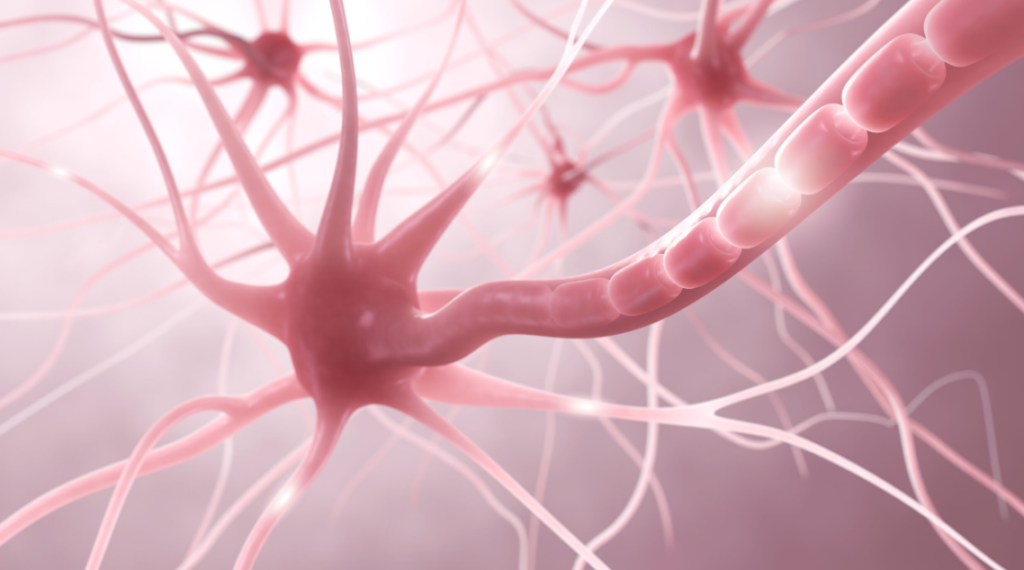Neuronal extracellular vesicles (NEVs) play a significant role in the communication between neurons and astrocytes, particularly by influencing metabolic processes such as glycolysis and lactate production. NEVs carry signaling molecules that affect the expression, degradation and oligomeric state of fructose 1,6-bisphosphatase 2 (Fbp2) in astrocytes, altering their metabolism (1).

Basic Backstory on CNS Architecture
The central nervous system (CNS) is composed of an intricate cellular communications complex, divided generally into neurons and glial cells. Neurons form the electrical signaling network, with dendrites receiving and integrating signals via chemical synapses, and axons, some up to 1 meter in length, rapidly transmitting the signals.
Glial cells, including astrocytes, microglia and other cells, interact with neuronal cells to sustain this network. For example, glial cells regulate synapse formation and provide metabolic support to promote CNS homeostasis. Glial cell dysfunction contributes to most neural diseases and can even drive neurodegenerative processes (2).
What are Neuronal Extracellular Vesicles (NEVs)?
NEVs are formed by neurons via endocytosis and are released into the extracellular space where they interact with astrocytes. These transport vesicles carry a variety of molecules, including proteins and RNA, that influence cellular processes in recipient astrocytes.
NEV and Astrocyte Interactions
Fbp2 is an important enzyme involved in glycogen synthesis that also has nonenzymatic functions, including support of neuronal processes like long-term potentiation (LTP). LTP underlies synaptic strength and plasticity and is important in both learning and memory formation.
One of the key effects of NEVs on astrocytes is the regulation of Fbp2 protein. NEVs reduce the level of Fbp2 in astrocytes, primarily by decreasing Fbp2 mRNA levels and increasing the degradation of the enzyme. This regulation occurs through the Pi3k/Akt signaling pathway, which leads to changes in the structure of Fbp2; the Fbp2 dimer has protective effects on astrocyte mitochondria, while the tetrameric form is associated with nuclear function and promoting cell division.
NEVs also promote the colocalization of Fbp2 within astrocyte mitochondria, helping to protect the mitochondrial membrane potential during metabolic stress, such as elevated calcium levels. This suggests that NEVs help astrocytes maintain mitochondrial health while supporting neurons metabolically.
NEVs and Lactate Metabolism
One of the most important outcomes of NEVs’ influence on astrocytes is the increase in glycolytic activity, resulting in greater lactate production. Lactate is a key energy substrate for neurons and is critical for processes like strengthening of synapses and memory formation. Lactate is produced by glycolysis, a major metabolic pathway responsible for glucose homeostasis and energy production. Once considered a mere byproduct of glycolysis, lactate is now considered an important regulatory molecule of intermediate metabolism.
NEVs significantly elevate the glycolytic capacity of astrocytes, increasing both glucose uptake and lactate release. Lactate can then be transported to neurons, where it is used in metabolic and signaling processes. This effect is critical for sustaining neuronal activity, especially during times of increased metabolic demand.
Conclusions
Neuronal extracellular vesicles are key mediators of neuron-astrocyte communication, influencing astrocytic metabolism, mitochondrial health and lactate production. This process supports neuronal function, particularly through metabolic crosstalk essential for long-term memory formation.
Detecting Lactate
Gizek et al. used the Lactate-Glo Assay to quantitate lactate in astrocyte culture medium with or without added NEVs (1). The Lactate-Glo Assay is a bioluminescent assay for rapid, selective, sensitive detection of L-lactate in biological samples.
References
1. Gizek, A. et al. (2024) Neuronal extracellular vesicles influence the expression, degradation and oligomeric state of fructose 1,6‑bisphosphatase 2 in astrocytes affecting their glycolytic capacity. Nature Scientific Reports 14, 20932. DOI: https://doi.org/10.1038/s41598-024-71560-7
2. Krämer-Albers, E-A. (2021) Extracellular Vesicles in neural cell interaction and CNS homeostasis. FASEB BioAdvances 3, 577–92. DOI: 10.1096/fba.2021-00035
Note: Gizek, A. et al. article has been updated to include acknowledgements. Accessed 10/17/24.
